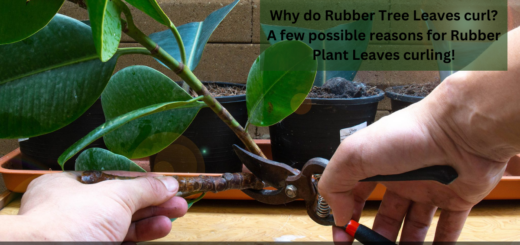What are Bay Trees? – How to Sow, Harvest, and Prune Bay Trees?
I decided to grow a bay tree in my garden not by buying a tree from a shop, but by using propagation methods. If you don’t know about propagation methods, don’t worry—I’ll explain. This guide covers not only propagating, but also methods of sowing, harvesting, and pruning bay trees.
After reading this guide, you will have all the information you need. Remember not to skip any part, as doing so could make your bay tree unhealthy. If you encounter any difficulties while growing it, feel free to leave a comment.
Bay Trees:
The bay tree, often called bay laurel, is a member of the laurel family. It comes from the Mediterranean region, but it can now be found all around the world. Bay trees may be found in ravines, woods, and thickets. It loves rich, well-drained soil (sandy soil, loam, and clay), as well as partial or full sun. Bay trees are grown for decorative purposes, as a condiment, and as a source of valuable oils used in cosmetics and medicine.
Key takeaways:
- The bay trees can grow up to a height of 20 to 30 feet or more.
- They can be seen in ravines, woods, and thickets.
- Good to be harvested in sandy, loam, and clay soil.
| Common Name | Bay laurel, laurel, laurel tree, bay tree, bay leaf, sweet bay |
| Botanical Name | Laurus nobilis |
| Family | Lauraceae |
| Plant Type | Tree, shrub |
| Mature Size | 10–60 ft. tall, 5–20 ft. wide |
| Sun Exposure | Full, partial |
| Soil Type | Moist, well-drained |
| Soil pH | Acidic, neutral, alkaline |
| Bloom Time | Spring, summer |
| Flower Color | Yellow |
| Hardiness Zones | 8–10 (USDA) |
| Native Area | Mediterranean |
| Toxicity | Toxic to pets |
Some Interesting Facts About Bay Trees
- The bay tree can grow as a single trunk tree or as a shrub with numerous trunks. It may grow to be 33 to 59 feet tall.
- The bark of the bay tree is smooth and generally greenish-gray or gray.
- The bay tree has evergreen, tough leaves that are trapezoidal. The midrib is prominent, and the borders are wavy.
- During the spring, the bay tree blossoms. On different trees, male and female flowers bloom (the bay tree is a dioecious plant). The flowers are star-shaped and yellow-green, and they are arranged in pairs. They are aromatic and full of honey, which doesn’t repel bees, and helps to pollinate the plant.
- Bay tree fruit is a purple to black drupe with one seed.
- Seed, cuttings, and air-layering are all methods of propagation for bay trees.
- Bay leaves that have been dried are often used to make herbal tea. The Bloody Mary drink contains ground bay leaves.
- The essential oils derived from bay leaves are utilized in the cosmetic sector to make a variety of soaps and massage oils.
- Bay leaves have a strong odor that repels a variety of insects. In the garden, they can be used instead of traditional pesticides.
- Walking sticks and ornamental objects made of multi-colored wood pieces are created from the wood of the bay tree (marqueterie work).
- Because of its powerful, fragrant scent, bay tree wood is occasionally used to smoke meat.
- In the wild, the bay tree may live for over 100 years.
How to sow Bay Tree Seeds?
- Choose a location that receives full to partial sun.
- Make a hole in the ground and fill it with manure or other organic waste.
- Fill the hole with water and keep the bay leaf plant equally wet.
- Check to see if the soil drains adequately.
- In the following years, fertilize in the spring and summer.
- Outdoors, bay plants grow to be quite tall. Prune to 5-6 feet if growing in a pot.
- Zones 7–10 are hardy. (Will only bring the temperature down to 20 degrees Fahrenheit.)
- Cuttings or air stacking are also effective methods of propagation.
- In the spring, flowers bloom, and in the fall, they convert into berries.
- Weak plants may draw aphids or scale, but they are generally pest-free.
How to Prune and Harvest Bay Leaves from a Bay Tree?
Bay trees (Laurus nobilis) can reach a height of 20 to 30 feet or more, but with careful pruning, they can be kept to a more manageable size. It’s a popular landscaping plant because of its dark green leaves. It’s simple to mold into a topiary. The lollipop, which has a single trunk and a rounded treetop, is the most common form. Bay leaves, whether fresh or dried, provide flavor to soups, stews, and sauces.
Types of Bay trees:
In order to use leaves for cooking and eating, planting bay laurel is a great option in your garden. There are other varieties of bays named sweet bay and bay but it is not compulsory for you can eat them as they can be toxic to eat. Here are some types of bay laurel:
Laurus nobilis f. angustifolia:
They are also known as willow leaf laurel. They tend to have narrow leaves and are known for their attractive texture.
Laurus nobilis ‘Aurea’:
These are types that have bright yellow color leaves having aromatic fragrances.
Laurus nobilis ‘Undulata’:
They do have lead edges that are rippled or wavy.
Laurus nobilis ‘Saratoga’:
These are bay types which are small trees if you plant them in a landscape that tends to grow 25 feet long. These are leaves having round shapes and are light in color. They are good for using them as food seasoning leaves.
Propagating Bay Laurel:
The following are some steps to propagate the bay Tree:
- During the summer season, you need to use sterile pruners so that you can take 6 inches of stem cutting from a green and healthy branch.
- You need to fill the pot with moist sand, coarse, and at the end dip the stamp cutting into the rooting hormone and then plant the cutting in the container.
- After planting the stem cutting you need to cover the container with the help of a plastic bag and use a rubber band to secure the bag.
- Keep the container in a warm location where it does receive bright indirect light.
- You will see the roots growing from the cutting within a month or two. After which you can remove the plastic bag from the container so that the plant continues growing to a large size.
- You can replant the stem cutting to a bigger size and keep it in the outdoor Garden location.
For more such plant related-articles, you may also read, Southern Shade Trees for Hot Climates in the Southern region – Best Shade trees for the Southern region
Pruning Bay Trees
- Research your plant and its surroundings. Decide on the form you want. Bay trees can be pruned as shrubs with several trunks or as single-trunk trees. With bay trees, skilled pruners create ornate topiary designs.
- Soak your pruning shears in a solution of 1 part bleach to 9 parts water to clean them.
- In the late spring, trim away any brown or withered leaf tips.
- Trim the crown of the bay tree to keep it at a manageable height.
- In late spring, shape topiary patterns across numerous trimming sessions, adding additional intricacy with each pruning. For branches with a diameter of one inch or more, use loppers.
- In the summer, prune the tree with pruning shears to encourage dense inner growth and to develop and maintain the ideal shape.
- Remove suckers that have sprung from the root. Look for side shoots on the trunk. Cut them off with pruning shears or pinch them off at the trunk.
- To keep the form, trim the leaves again after the summer. Long branches that have outgrown their intended form should be removed.
Harvesting the Bay Leaves
- Harvest individual bay leaves at any time for fresh usage. Hand-pick the required amount of leaves.
- Gather bay leaves from clipped trees and save them for later use. The leaves can be dried in the sun, in a dehydrator, or in an oven set to the lowest temperature possible. The recommended drying temperature is 110 degrees Fahrenheit. Crisp leaves indicate that they are properly dried.
- Put dried leaves in an airtight plastic or glass jar to keep them fresh. Keep the container somewhere dark and dry.
About the article
The bay tree, often called bay laurel, is a member of the laurel family. It comes from the Mediterranean region, but it can now be found all around the world. Bay trees may be found in ravines, woods, and thickets. In this article, we discussed bay trees. We also discussed how to sow, harvest, and prune them.


